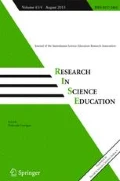Abstract
Laboratory work is seen as an integral part of most science courses; however, a significant proportion of laboratory activities remain highly prescriptive and fail to challenge many secondary science students. This study of senior high school biology, chemistry and physics laboratory environments drew data from student responses to theScience Laboratory Environment Inventory (SLEI) and a curriculum analysis of the implemented laboratory tasks. The study involved 387 biology, chemistry and physics students in 20 classes in Tasmania, Australia. The curriculum analysis was based on Lunetta and Tamir’sLaboratory Structure and Task Analysis Inventory and theLaboratory Task Analysis. The study found that the SLEI did differentiate between the three subject areas and that theLaboratory Structure and Task Analysis Inventory confirmed the more open-ended nature of the school physics in vestigations evident from students’ responses to the SLEI.
Similar content being viewed by others
References
Australian Academy of Science. (1990).Biology, the common threads. Part 1. Canberra: Australian Academy of Science.
Bucat, R. B. (Ed.). (1983).Elements of chemistry (Vol. 1,2). Canberra: Australian Academy of Science.
Fisher, D. L., Henderson, D. G., & Fraser, B. J. (1997). Laboratory environments and student outcomes in senior high school biology.The American Biology Teacher, 59, 214–219.
Fraser, B. J. (1994). Research on classroom and school climate. In D. Gabel (Ed.),Handbook of research on science teaching and learning (pp. 493–541). New York: Macmillan.
Fraser, B. J. (1998). Science learning environments: Assessment, effects and determinants. In B. J. Fraser & K. G. Tobin (Eds.).The international handbook of science education (pp. 527–564). Dordrecht, The Netherlands: Kluwer.
Fraser, B. J., McRobbie, C. J., & Giddings, G. J. (1993). Development and cross-national validation of a laboratory classroom environment instrument for senior high school science.Science Education, 77, 1–24.
Fuhrman, M., Lunetta, V. N., & Novick, S. (1982). Do secondary school laboratory texts reflect the goals of the “new” science curricula?.Journal of Chemical Education, 59, 563–565.
Haertel, G. D., Walberg, H. J., & Haertel, E. H. (1981). Socio-psychological environments and learning: A quantitative synthesis.British Educational Research Journal, 7, 27–36.
Hegarty, E. H. (1978). Levels of scientific enquiry in university science laboratory classes: Implications for curriculum deliberations.Research in Science Education, 8, 45–57.
Herron, M. D. (1971). The nature of scientific enquiry.School Review, 79 171–212.
Johnstone, A. H. (1991). Why is science difficult to learn? Things are seldom what they seem.Journal of Computer Assisted Learning, 7, 75–83.
Kent, H. A., & Fisher, D. L. (1997, March).Associations between, teacher personality and classroom environment. Paper presented at the Annual Meeting of the American Educational Research Association, Chicago, IL.
Lunetta, V. N., & Tamir, P. (1979). Matching lab activities with teaching goals.The Science Teacher, 46, 22–24.
McRobbie, C. J., & Fraser, B. J. (1993a). Associations between student outcomes and psychosocial science environment.Journal of Educational Research, 87, 75–85.
McRobbie, C. J., & Fraser, B. J. (1993b, November).A typology for university and school science laboratory classes. Paper presented the annual conference of the Australian Association for Research in Education, Perth.
Nunnally, J. (1967).Psychometric theory. New York: McGraw Hill.
Tamir, P., & Lunetta, V. N. (1978). An analysis of laboratory inquiries in the BSCS yellow version.The American Biology Teacher, 40, 353–357.
Tamir, P. (1991). Practical work in school science: An analysis of current practice. In B. E. Woolnough (Ed.),Practical science: The role and reality of practical work in school science. Milton Keynes, England: Open University Press.
Taylor, P., Dawson, V., & Fraser, B. J. (1995, April).CLES: Classroom learning environments under transformation: A constructivist perspective. Paper presented at the Annual Meeting of the American Educational Research Association, San Francisco, CA.
Teh, G., & Fraser, B. J. (1994). An evaluation of computer-assisted learning in terms of achievement, attitudes and classroom environment.Evaluation and Research in Education, 8, 147–161.
Wong, A. F. L., & Fraser, B. J. (1995). Cross-validation in Singapore of the science laboratory environment inventory.Psychological Reports, 76, 907–911.
Woolnough, B. E. (1991). Practical science as a holistic activity. In B. E. Woolnough (Ed.),Practical science: The role and reality of practical work in school science (pp. Xx-xx), Milton Keyes, England: Open University Press.
Wubbels, T., Creton, H., Levy, J., & Hooymayers, H. (1993). Themodel for interpersonal teacher behavior. In T. Wubbels, & J. Levy (Eds.),Do you know what you look like? Interpersonal relationships in education (pp. 13–28). London: Falmer Press.
Author information
Authors and Affiliations
Corresponding author
Rights and permissions
About this article
Cite this article
Fisher, D., Harrison, A., Henderson, D. et al. Laboratory learning environments and practical tasks in senior secondary science classes. Research in Science Education 28, 353–363 (1998). https://doi.org/10.1007/BF02461568
Issue Date:
DOI: https://doi.org/10.1007/BF02461568




